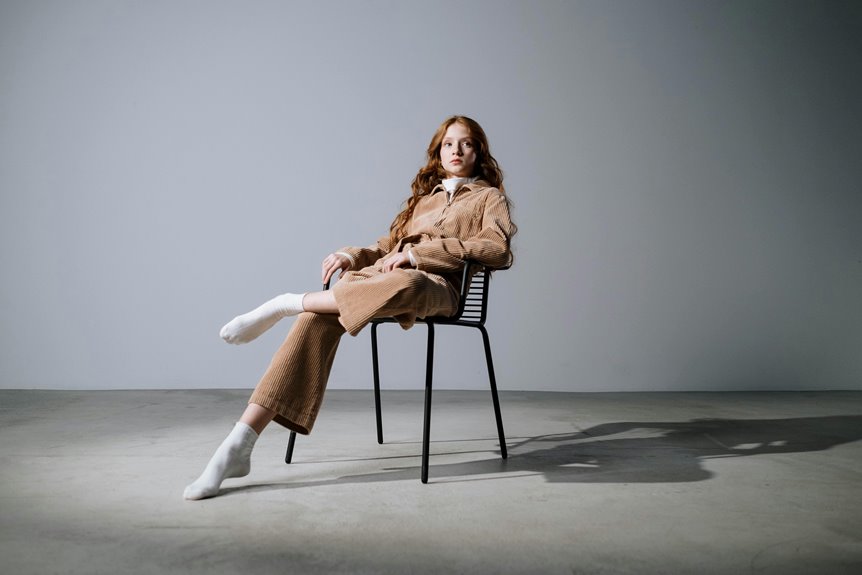When choosing the best wale corduroy for your fabric projects, consider the ridge size to match your style and durability needs. Fine wale offers smooth, lightweight texture perfect for sleek or formal wear. Wide wale features bold, chunky ribs ideal for statement pieces but can be stiffer. Medium wale balances texture and flexibility for versatility. Also, factor in how the fabric will drape and wear. Keep these tips in mind, and you’ll be set to explore more sewing and styling techniques.
Table of Contents
Key Takeaways
- Select fine wale corduroy for smooth texture and polished look in formal or lightweight garments.
- Choose wide wale corduroy for bold texture and durable statement pieces or vintage-inspired designs.
- Medium wale corduroy suits versatile projects needing balance between durability and softness.
- Match wale size to fabric purpose: narrow wales resist wear; wider wales add texture but may be stiffer.
- Consider fabric drape and movement; wider wales are stiffer, impacting garment flexibility.
Understanding Wale Size in Corduroy
Although wale size might sound technical, it’s simply the number of ridges per inch in corduroy fabric.
When you look closely at corduroy, you’ll notice these raised lines or “wales” running parallel. The wale size affects the fabric’s texture and appearance markedly.
Smaller wale counts mean thinner ridges, giving the fabric a smoother, finer feel. Larger wale counts create wider ridges, resulting in a chunkier, more pronounced texture.
Thinner ridges offer a smooth, refined fabric feel, while wider ridges provide a bold, textured look.
Knowing this helps you decide the right corduroy for your project, whether you want a sleek look or a bold, tactile effect.
Different Types of Wale Corduroy and Their Uses
When choosing wale corduroy, you’ll find three main types to evaluate: fine wale, medium wale, and wide wale.
Each type offers a different texture and durability, making them suited for specific uses.
Let’s look at how these variations can match your style and needs.
Fine Wale Corduroy
Fine wale corduroy features narrower ridges than other types, making it a versatile choice for both casual and formal wear.
When you pick fine wale corduroy, you get a fabric that’s soft, lightweight, and drapes well. This makes it perfect for tailored clothing like blazers, trousers, and skirts, giving your outfit a polished look without sacrificing comfort.
Because the ridges are subtle, fine wale corduroy also works great for shirts and dresses, adding texture without overwhelming your style.
Plus, it’s easier to maintain and less prone to wear compared to wider wale varieties.
If you want a fabric that balances durability and elegance, fine wale corduroy is an excellent option for a range of projects.
Wide Wale Corduroy
How do you choose the right wide wale corduroy for your wardrobe?
Wide wale corduroy features thick, prominent ribs, giving your garments a bold texture and vintage vibe. It’s perfect when you want fabric that stands out and offers durability.
When selecting wide wale corduroy, consider these factors:
- Weight and Thickness: Heavier fabrics are great for jackets or pants, while lighter ones suit skirts or shirts.
- Color and Finish: Choose vibrant or muted tones depending on your style; a matte finish feels casual, while a slight sheen adds sophistication.
- Stretch and Comfort: Some wide wale corduroys include elastane for flexibility, ideal for active wear.
Keep these points in mind to pick wide wale corduroy that fits your fashion needs and comfort preferences.
Medium Wale Corduroy
Anyone looking for versatile fabric will find medium wale corduroy a great choice.
With wale widths typically between 10 and 12, it strikes a perfect balance—offering texture without overwhelming your design. You can use it for clothing like jackets, trousers, and skirts, providing durability and comfort.
Its moderate wale size adds subtle visual interest without being too bold, making it ideal for both casual and semi-formal wear.
Beyond apparel, medium wale corduroy works well for upholstery and home décor, giving a cozy, classic feel.
If you want a fabric that’s sturdy yet flexible, medium wale corduroy fits the bill.
It’s easier to sew than wide wale and holds up better than fine wale, making it a reliable choice for a variety of projects.
How to Choose the Right Wale Size for Your Project
You’ll want to contemplate how wale size affects both the look and feel of your project.
Finer wales create a smoother texture, while wider wales add more depth and durability.
Make sure the wale size you choose matches the fabric’s purpose and your design needs.
Wale Size Impact
Since wale size determines the texture and durability of corduroy, selecting the right one is essential for your project’s success.
The wale size affects not only the fabric’s look but also how it handles wear and tear. When choosing, consider how the wale impacts:
- Appearance: Fine wales offer a smooth, subtle texture, while wider wales create bold, pronounced ridges.
- Durability: Narrow wales tend to be more durable and resistant to abrasion, ideal for frequently worn items.
- Flexibility: Larger wale cords can be stiffer, affecting how your fabric drapes and moves.
Project Fabric Compatibility
When selecting corduroy for your project, matching the wale size to the fabric’s intended use guarantees the best results.
Fine wale corduroy, with its narrow ribs, works well for lightweight garments like shirts or dresses, offering a smooth, subtle texture.
Medium wale suits casual pants or jackets, providing durability without overwhelming the design.
For heavy-duty or statement pieces, wide wale corduroy stands out, adding bold texture and strength.
Consider the garment’s drape and comfort—smaller wales tend to be softer and more flexible, while larger wales are stiffer.
Also, think about the look you want: fine wales are refined, wide wales are rugged.
Tips for Sewing With Various Wale Corduroy Fabrics
Although sewing with wale corduroy can pose unique challenges, understanding the fabric’s texture and wale size helps you achieve clean, professional results. Each wale size demands a slightly different approach to guarantee your stitches don’t get lost or the fabric doesn’t pucker.
Here are some tips to help you sew various wale corduroy fabrics effectively:
- Use a sharp needle, preferably size 90/14 or 100/16, to penetrate thick wale fabrics without damaging fibers.
- Adjust stitch length to 3mm or longer for wider wales, which prevents perforations and fabric weakening.
- Press seams carefully with a steam iron on a low setting, using a pressing cloth to avoid crushing the pile.
Styling Ideas Based on Wale Corduroy Texture
Because wale corduroy varies in texture and wale thickness, you can tailor your styling choices to highlight its unique character.
For fine wale corduroy, opt for tailored pieces like slim-fit trousers or fitted jackets; these emphasize the fabric’s sleek lines and offer a polished look.
Medium wale works well for casual wear such as skirts or relaxed blazers, providing a balance of texture and comfort.
Chunky wale corduroy shines in outerwear or statement pieces, adding bold texture and visual interest.
Chunky wale corduroy brings bold texture and striking detail to your standout outerwear and statement pieces.
When mixing, pair wale corduroy with smooth fabrics like silk or denim to create contrast.
You can also play with color layering—lighter wale fabrics pair beautifully with darker tones, making your outfit pop without overwhelming it.
This approach guarantees your project stands out with style and sophistication.
Maintaining and Caring for Wale Corduroy Fabrics
Since wale corduroy has a distinct texture and structure, you’ll want to handle it with care to keep it looking sharp. Proper maintenance extends its life and preserves its unique appearance.
When caring for wale corduroy, focus on gentle handling and cleaning methods.
Here are three key tips to maintain your wale corduroy fabric:
- Wash carefully: Use cold water on a gentle cycle or hand wash to avoid damaging the wales.
- Avoid high heat: Air dry or tumble dry on low to prevent shrinking and maintain texture.
- Brush regularly: Use a soft brush to lift the nap and remove dirt, keeping the fabric fresh.
Following these steps will help your wale corduroy projects stay vibrant and well-structured over time.
Frequently Asked Questions
Can Wale Corduroy Be Used for Upholstery Projects?
You can definitely use wale corduroy for upholstery projects. It’s durable, textured, and adds warmth to furniture. Just pick a wale size that suits your style and guarantee the fabric’s heavy-duty enough for frequent use.
Is Wale Corduroy Suitable for Summer Clothing?
Wale corduroy can be suitable for summer clothing if you pick a lighter weight and finer wale. It breathes better and feels softer, so you won’t get too hot while still enjoying its unique texture.
How Does Wale Corduroy Compare to Velvet in Texture?
Wale corduroy feels like soft ridges under your fingers, offering a textured, ribbed surface, while velvet’s smooth, plush pile feels like touching velvet petals. You’ll notice corduroy’s structure contrasts velvet’s sleek softness instantly.
Are There Eco-Friendly or Organic Wale Corduroy Options?
Yes, you can find eco-friendly wale corduroy made from organic cotton or recycled fibers. These options use sustainable dyes and processes, so you’re helping the planet while still getting that classic textured look you love.
What Is the History Behind Wale Corduroy Fabric?
They say, “Rome wasn’t built in a day.” You’ll find wale corduroy dates back to the 18th century, originally crafted for durability in workwear before becoming a stylish, comfy fabric loved worldwide today.
- Does Chiffon Fabric Stink - July 15, 2025
- Does Chiffon Fabric Affect the Economy - July 15, 2025
- Does Cotton Fabric Have a Nap - July 15, 2025







